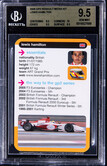


27/02/2024
NEWS STORY
No other F1 driver shifts as much merchandise as Lewis Hamilton.
Long before Drive to Survive lit up the American audience, Hamilton launched a wildly-popular range of colourful limited edition caps and now collaborates on a clothing range with renowned Japanese designer Takashi Murakami. Such is the level of interest in the seven-time champ that even though his tee shirts have a £70 price tag they sell out and go for more than double that on the second hand market. However, Hamilton's halo effect stretches far beyond clothes.
In other areas of cooperation, Lewis Hamilton and Hajime Sorayama collaborated to launch racing helmets and cooperated with IWC to launch limited edition watches, etc. Fans have sought after these products.
But of course many fans watch Lewis Hamilton matches and enjoy betting on F1 races, that is why this sport has so many sponsors. If you want to make some bets too, you can go to the 1xbet site.
 Fans' love for him and the F1 event has also given rise to many peripheral products, such as customized racing pins, Custom Cufflinks - racing car shapes, customized racing key chains, and other products, that can be worn around them.
Fans' love for him and the F1 event has also given rise to many peripheral products, such as customized racing pins, Custom Cufflinks - racing car shapes, customized racing key chains, and other products, that can be worn around them.
In September 2020 F1 signed a deal with merchandise manufacturer Topps to produce a range of trading cards for the sport. The timing couldn't have been better.
Interest in trading cards surged during the pandemic as collectors began searching through their stockpiles when they were stuck indoors. Online trading boomed and F1 was swept along with it, especially in the United States which has perhaps the longest tradition of trading card collecting anywhere in the world.
The pandemic fuelled F1's popularity in the US as Americans in lockdown began looking for new content on Netflix and came across Drive to Survive. In no time at all Gunther Steiner's profane outbursts went viral and the rest is history.
For obvious reasons, sports fans were quickest to catch on to Drive To Survive and they are also the most likely trading card collectors. The smartest amongst them started snapping up F1 trading cards mindful of the massive gains to be had.
In August 2022 a card of 1950s baseball player Mickey Mantle sold for a record £10 million ($12.6 million). It went for such a large sum because it was what is known as his rookie card meaning that it was released in his first professional, or major league, season. Rookie cards are the most collectible as the stars aren't as famous when they are released so fewer are sold which makes them rarer. The cards also carry kudos as they show that their owners had the foresight to see the athlete's talent at an early stage.
 F1's new breed of fans wanted a piece of that action so collectors started searching for trading cards of drivers who could be future F1 stars. The frenzy has seen cards for lower ranking drivers like Zhou Guanyu sell for more than £15,834 ($20,000) whilst ones for names at the sharp end of the grid have gone for much more.
F1's new breed of fans wanted a piece of that action so collectors started searching for trading cards of drivers who could be future F1 stars. The frenzy has seen cards for lower ranking drivers like Zhou Guanyu sell for more than £15,834 ($20,000) whilst ones for names at the sharp end of the grid have gone for much more.
The most historic and credible trading card platform is called Goldin and in 2021 its most expensive F1 trading card sold for £46,709 ($59,000). Not bad but not a patch on the staggering £712,512 ($900,000) that a Hamilton Chrome F1 Superfractor Topps card sold for in 2022.
The sale almost made one lucky Hamilton fan a millionaire and it set an all-time record for an F1 trading card. It was far from a one off as a Max Verstappen card also hit £422,768 ($534,000). Remarkably both of these cards were produced in just the past four years so heritage doesn't seem to be the driving force behind the price. A recent listing for a Lewis Hamilton card on Goldin turns all that on its head.
The card in question pre-dates the current collection of F1 cards by a massive 14 years and was released directly by the sport's rights holder itself rather than a third party licensee like Topps.
Released at the start of 2006, the card shows a bright-eyed Hamilton in his first season of GP2, the junior series now known as F2. On one side the card shows stats about Hamilton's career to date as well as a photo of his ART Grand Prix car in pre-season testing at Paul Ricard whilst on the other side there is a GP2 logo as a reminder that that the card is official.
The closest comparison is a card made by a company called Futera which was sold later in the 2006 season and wasn't released by GP2, hence the lack of the logo to the series. Despite this, the Futera card sold for £247,020 ($312,000) on Goldin in 2022 such is the interest in Hamilton's history.
The card currently listed on Goldin is the first ever official one of Hamilton and is from his rookie year as 2006 was his first professional season. GP2 was the feeder series to F1 and all but one of its races took place at a Grand Prix. Importantly, before that, Hamilton raced in F3 which did not have a single championship at the time. There were regional variants and Hamilton raced in the Formula 3 Euro Series.
The only trading card of Hamilton in 2005 was given out in a Czech magazine called Formule and even that went for £13,301 ($16,800) on Goldin. If anything shows Hamilton's star power it's that.
The quality of the cards affects their value and the one released by GP2 has been graded by card experts Beckett as Gem Mint which is apparently almost at the top of the tree. It is the only official card of Hamilton from his debut season which he went on to win before stepping up to F1 the following year with McLaren.
Describing it as Hamilton's rarest trading card isn't an opinion as the Goldin listing states that "this is the only known example of this ultra-elusive Hamilton collectible to surface at auction".
The card is so rare because it was never sold in shops. The listing says that the card comes from a collection which was given to the few journalists (not even Pitpass) who were reporting on GP2 in 2006 when it was only in its second season. The collection came with a card guide which doubled up as a media kit - a relic from the days before they were given out on USB sticks, let alone online. Cleverly, the pages of the guide were in a binder so that GP2 could swap in new drivers if any of them dropped out before the start of the season.
Beckett's website has photos of the other cards in the collection which include ones of 'Crashgate' star Nelson Piquet jr, and other former F1 drivers such as Timo Glock and Lucas di Grassi. The Hamilton card has something that its counterparts from Topps cannot match and that's actual history which will presumably increase on his switch to Ferrari next year and when he eventually retires after that. The lack of an official trading card from his debut F1 season adds to its significance and is evidence of a more troubling trend in the sport.
The only Topps cards which could legitimately be described as rookie F1 cards are those of Nicholas Latifi, Pietro Fittipaldi and Jack Aitken as their first season in the sport was 2020. Despite this, F1 announced the Topps deal with so much fanfare that a number of collecting websites refer to them as being the drivers' first official trading cards but, as the one of Hamilton clearly shows, this is far from the case.
It's almost as if history was being re-written with the Topps deal and there's a sense of déjà vu about that...
In the run up to last year's Las Vegas Grand Prix the race often seemed somewhat of an afterthought as fans were bombarded with a steady stream of boasts. We were told about the Million Dollar tickets, the acts playing at the opening event, the lavish parties and even the video which would be playing on the giant LED sphere beside the track. There was so much hullabaloo that you could be forgiven for thinking it was the first time F1 had ever raced in Sin City even though it actually first went there more than four decades ago.
Ever since Liberty Media bought F1 in 2017 it has made it seem like it was breaking new ground in the sport. We were given the impression that the F1 TV streaming service gave fans access and interactivity for the first time. That's if you ignore the F1 Digital+ platform which allowed viewers to switch between the cars' onboard cameras back in 1996.
In 2019 F1's then-CEO Chase Carey claimed that the sport had "launched its first-ever sustainability strategy". In fact, the first one followed F1's inaugural carbon audit in 1998. In 2007 the FIA even announced that F1 was already carbon neutral thanks to it contributing to the planting of trees in Mexico so the sport had already taken decisive action more than a decade before Carey launched his sustainability strategy.
Then there were claims that F1's former head of marketing was the company's first female executive. Tell that to Sacha Woodward-Hill who became F1's chief legal officer in 1999 or Kate Beavan who joined her in 2003.
The much-vaunted "We Race As One" campaign (remember that?) was positioned as being a step into new territory when in fact the FIA launched "Racing Against Racism" all the way back in 2008. Perhaps the zenith was the claim from F1's former commercial chief Sean Bratches (remember him?) that when Liberty bought the company "there was no business." He explained that there was "no digital structure, no market research, nothing." If that isn't an exaggeration then we don't know what is. In fact, it makes you wonder why Liberty paid £6.3 billion ($8 billion) to buy F1 in the first place.
Boasts aside, the only way to see the real impact of Liberty is by looking at the numbers. The businesses involved with running F1 have chopped and changed over the past 20 years but one has remained the same - the company which directly owns the rights to the sport. It does the same job now that it did 20 years ago, all that has changed is its name - Formula One World Championship now and Formula One Administration 20 years ago.
The company's latest results are for 2022 which is six years after Liberty took over the sport. Its impact can be seen by comparing the company's performance over that period with the first six years that its predecessor CVC was in charge. Over CVC's first six years in the driving seat revenue rose by 51.1% to £950 million ($1.2 billion) with an operating profit of £272.2 million ($343.8 million). In contrast, over the first six years that Liberty has been at the wheel revenue has increased by 31.5% to £1.5 billion ($1.9 billion) with an operating profit of £166.5 million ($210.3 million). Given all the hype that surrounds F1 you would have never guessed this and that is perhaps the winning formula.